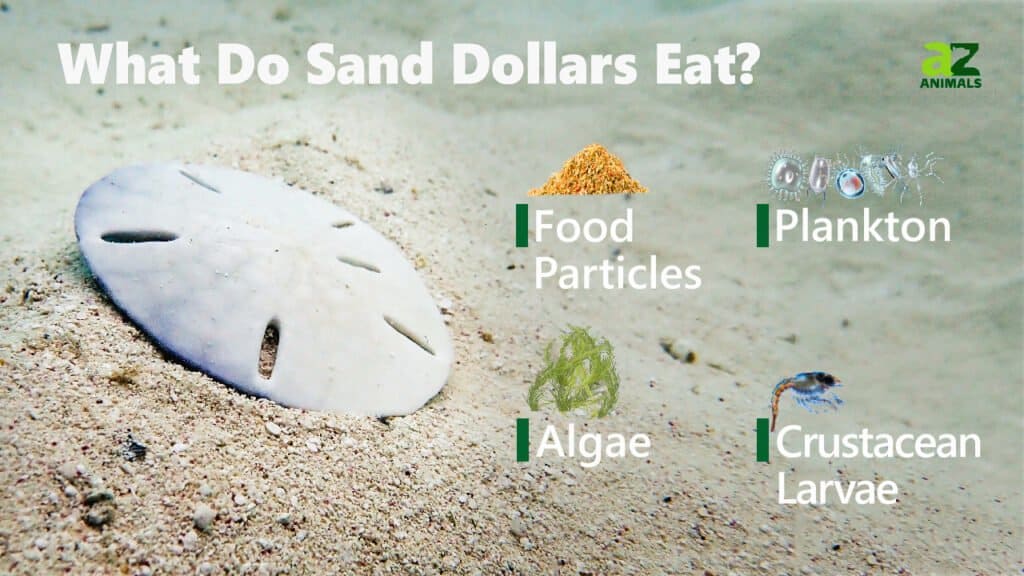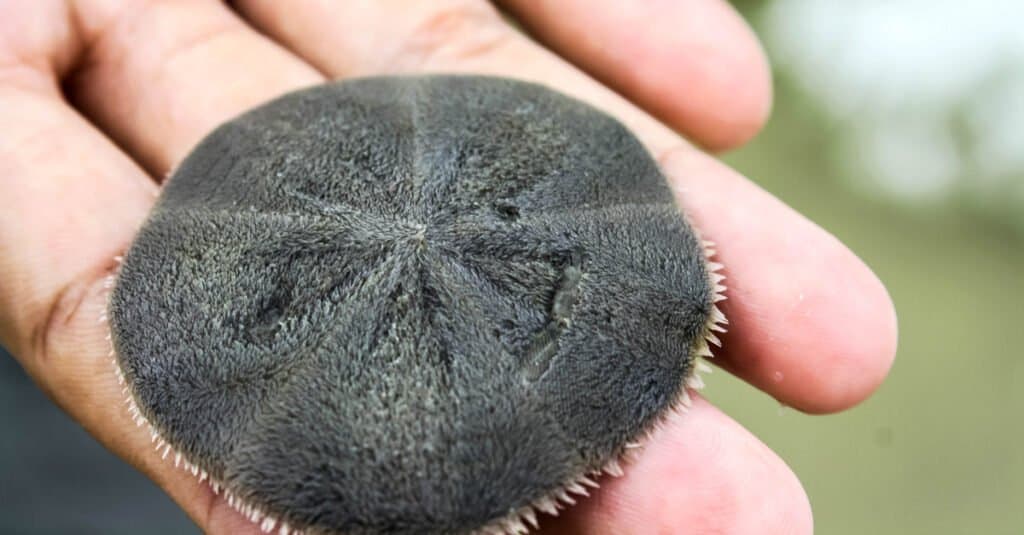The sand dollar (Echinarachnius parma) looks like a silver dollar. They are flat invertebrate marine animals whose close relatives are sea urchins, sea cucumber, and starfish.
Also, their skeletal structure is called a test and has a curved pentagonal shape. A live sand dollar is patterned like an irregular circle, and it is covered by a velvet-like spine with a projection of “hairs” known as cilia. The cilia aids feeding by moving food to the mouth, located at the center under the sand dollar.
We have prepared this article on what sand dollars eat to create awareness and fill in any lack of information thereof.
What Do Sand Dollars Eat?

Sand dollars are omnivores that eat debris, small copepods, diatoms, microscopic algae, crustacean larvae, and aquatic insects. Sand dollars are completely aquatic, and as a consequence, any terrestrial visitation is death-dealing. Due to this constriction, sand dollars mostly eat their neighbors. The sand dollar is quite similar to the starfish in the positioning of the mouth organ, located at the center and underneath both critters.
What sand dollars eat also depends on the style they have applied during feeding time. A study in the Journal of Experimental Marine Biology and Ecology shows that sand dollars can eat deposited or suspended food particles. And it goes on to explain the repositioning required to access these foods. Deposited food particles refer to detritus, while suspended food is a mix of living and dead organic matter.
So, sand dollars and their larvae would use a suspension-feeding system to get planktons, microalgae, and even the larvae of other bottom dwellers as the ocean current moves these particles from point to point.
Complete List Of Foods Sand Dollars Eat?
Sand dollars eat both animals and plant matter. However, seeing them for the first time might make you doubt and question how they can eat some of the organic matter. Their cilia catch these food particles and move them to the mouth of the creature.
Here’s a complete list of food sand dollars eat:
- Flies
- Planktons
- small copepods
- Diatoms,
- Sponges
- microscopic algae,
- Bivalve
- Aquatic insects
- crustacean larvae,
- Kelp
- Detritus
- Larvae
- Shrimp
How Do Sand Dollars Hunt For Food?

It takes sand dollars two days to digest what they eat
©Reptilian/Shutterstock.com
The spiny skin with cilia protrusion on both sides of the sand dollar is more than something to cover the skeleton. In addition to this essential function, the cilia are in charge of all motions, including transportation of food to the mouth.
Other motions necessary for hunting food, such as burrowing or creeping are equally enabled by cilia, as the sand dollar looks and sifts the sand of the ocean floor for what to eat. Another way the sand dollar has evolved is to swim on its side to catch any other organisms carried by the ocean current.
Sand dollars have five rows of “teeth,” which they use to catch prey and chomp on food. This should hasten their digestion, you would think, but the sand dollar takes approximately two days to digest meals. Another ingenuity of these animals is that they ingest sediments to help weigh them down. This adaptation ensures they are not swept away by the ocean current or eaten by predators.
What Do The Larvae of Sand Dollars Eat?

Sand dollar’s larvae eat mostly plankton
©k_lmnop/Shutterstock.com
The babies of sand dollars are omnivorous right from the start. Their conception happens depending on the whims of the ocean. This is because when sand dollars happen to breed, they do so by ejecting their sperm and egg into the environment they are in. If it so happens that the ocean is kind enough to bring the sperm and egg together, then a larva is begotten!
The larvae of sand dollars eat mostly plankton, and they are omnivorous right from the early stages. However, the plankton that would become food have to be very small (microscopic in fact) because the larvae are tiny themselves. With no parental protection and provision, it is a wonder that sand dollars are still in existence.
Who Competes With Sand Dollars For Food?
The majority of the members of the phylum Echinodermata are the sand dollars competitors. They do not just have the same features, but their behaviors are also similar. These invertebrates feed on plankton, algae, and detritus.
Here’s a list of animals that compete with sand dollars for food:
- Starfish
- Sea urchins
- Brittle star
- Sea cucumber
- Snails
- Clams
- Sea lily
- Aquatic earthworms
- Water scorpions
- Sea horses
- Fishes
- Tadpoles
- Cope pods
- Cladocerans
- Flies and their larvae
What Eats Sand Dollars? A List of Their Predators
Sand dollars are occasional prey to other aquatic predators. Some of these predators are listed here, but keep in mind that the list cannot possibly include every known predator given that sand dollars are lower down the food chain.
- Fish: fishes such as cod, wrasses, triggerfish, Californian sheepshead, haddock, and flounder
- Crab: sand crab, king crab, hermit crab, and stone crab
- Sea Star
- Otter
- Octopus
- Snail
- Sunflower starfish
- The Ocean Pout
- Nurse shark
Can Sand Dollars Defend Themselves?
Sand dollars are part of the phylum Echinodermata. Therefore they have spiny skin and tough bristles covering their entire body as a means of self-defense. Other defensive actions they adopt include burying themselves in the sand to hide from the predator and consuming deposits to weigh themselves down to the bottom of the ocean floor. The tools that make this possible, yeah, you guessed right, the cilia!
The cilia are in charge of movement and do their job by digging a hole for the sand dollar to hide in.
The larva of the sand dollar also has a natural ability to create a clone of itself to evade predators. Science fiction? Nope, this has been proven by extensive research. A study in the Journal of Young Investigators shows that larvae as young as four days old are capable of the feat.
Can Sand Dollars Be Kept As Pets?
Yes, you can keep sand dollars as pets. They only need water, not forgetting the fact that they are marine creatures. Also, raising them in an aquarium with other pets removes any responsibility of feeding since they automatically obtain food from the habitat you have made.
The photo featured at the top of this post is © k_lmnop/Shutterstock.com
Thank you for reading! Have some feedback for us? Contact the AZ Animals editorial team.






